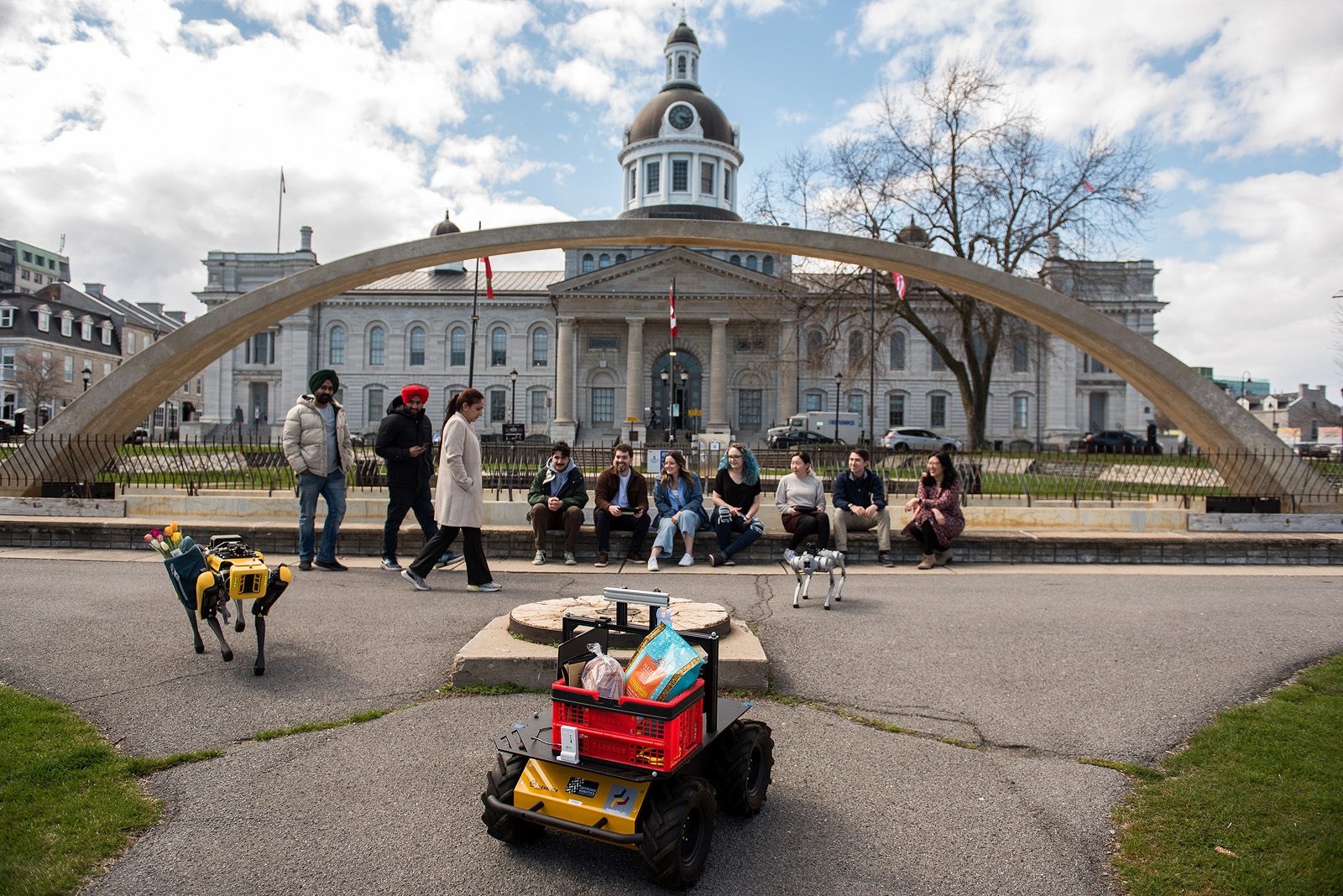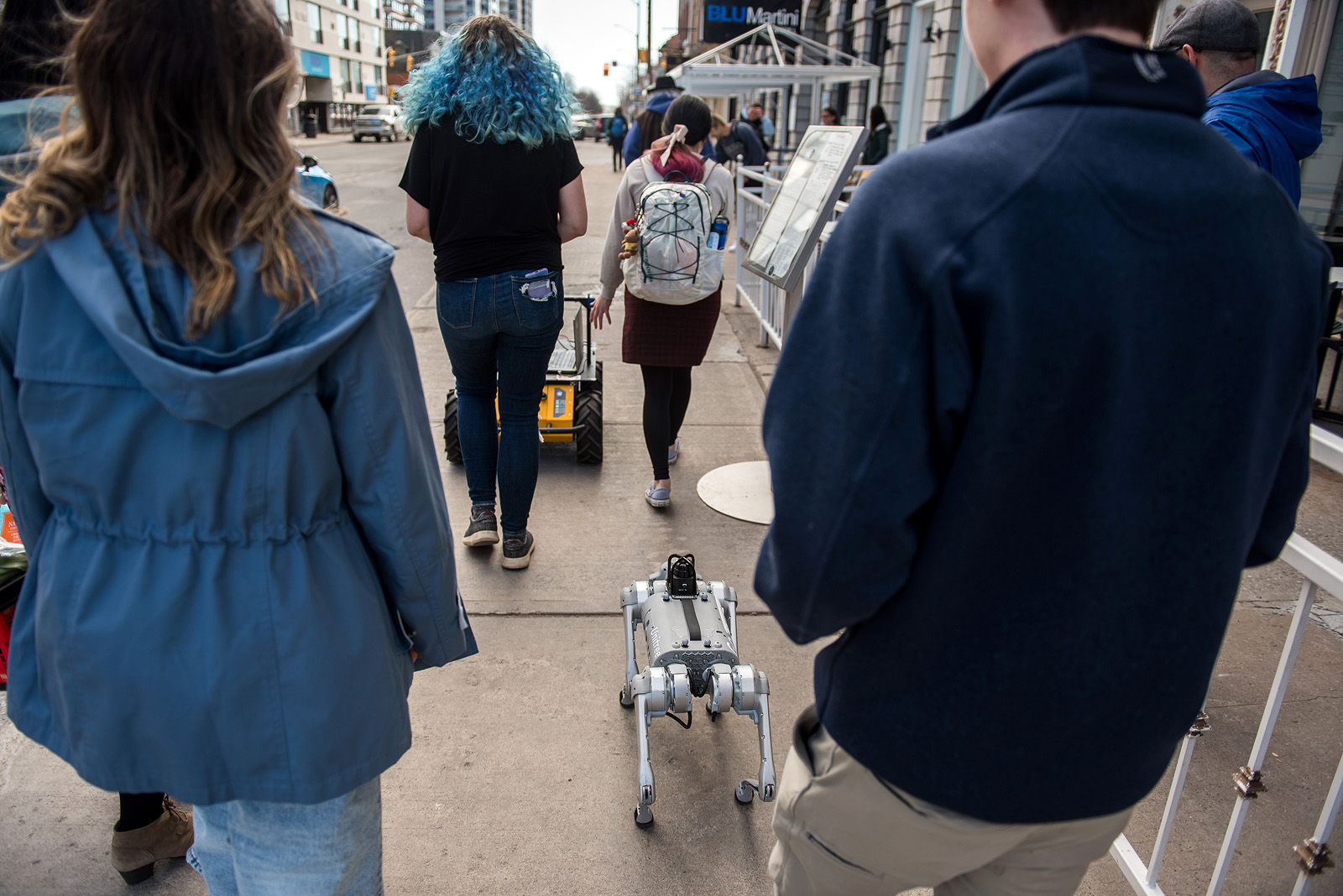
Amy Wu believes it’s time to liberate the robots, and she’s confident a new training program based out of Queen’s Ingenuity Labs Research Institute will help make that happen.
Called the Advanced Engineering and Training in Next-Generation Mobile Robotics for Human Spaces (ADVENTOR), the multidisciplinary program aims to give about 60 graduate students in engineering the skills needed to design mobile robots that can interact with humans.
Wu is an Assistant Professor in the Department of Mechanical and Materials Engineering and the co-lead of ADVENTOR, which is set to launch this September. It is funded by an NSERC Collaborative Research and Training Experience program grant of $1.65 million over the next six years.
Wu is the lead researcher of ADVENTOR’s team of 11 faculty members from Smith Engineering, Queen’s Department of Psychology, University of Ottawa, McGill University, University of Toronto, and University of Waterloo.
There are also several partners from the robotics industry involved, as well as the City of Kingston.
Wu says that together the group will tackle one thorny question at the heart of current robotics research: how to safely unleash the potential of moving robots across a range of settings, from city streets to homes.
At the moment, most robots fall short of this potential because they are often restricted to bounded or fixed locations and isolated from people for safety reasons, she says.
“Think of a warehouse, for instance,” she says. “If you have a robot helping on the floor, then you have to monitor the robot, so it doesn't collide with humans. That’s not really an effective use of the robot’s or the human’s time.”
The problem is that freeing robots so that they can safely coexist and interact with people introduces a whole battery of new technical, social, and ethical questions not typically covered by existing graduate training programs, she adds.
ADVENTOR will change that, according to the program co-lead, Joshua Marshall. A Professor in the Department of Electrical and Computer Engineering, Marshall is also the Director of Ingenuity Labs. He believes that the research institute is the perfect place for that change to begin in Canada.
“At Ingenuity Labs, we push the boundaries of how we research Artificial Intelligence and robotics, and it is evidenced by projects like this one,” he says. “This ADVENTOR program is really dependent on the kind of multidisciplinary, collaborative environment that we’re building here.”
Marshall and Wu say that ADVENTOR will be structured around two main research themes: “Robots in the Home” and “Robots in the City.”
The first will tackle how to design and integrate robots into homes so that they can safely assist with daily living. Studies show that an increasing number of older adults want to age at home. Social robots could help them do that by assisting with activities like getting out of bed or putting on clothes, says Wu.
But as she notes, most current social robots are made of heavy, rigid materials. “That’s not a great dynamic to have to encourage interaction with the elderly. You could potentially harm them. So we’re trying to think of the different factors that we can tackle to make those robots safe and effective.”
The Robots in the City theme will be about monitoring and deploying robots in public spaces. This could mean designing robots that can inspect bridges and buildings, detect when streets and sidewalks need to be cleaned or repaired, or even deliver defibrillators to emergency responders.
The City of Kingston has been an important partner in the development of this theme.
“We’re pleased to be a partner,” says Craig Desjardins, the City of Kingston’s director of strategy, innovation and partnerships. “As a municipal government that delivers services across multiple sectors, it is critical that we explore opportunities to innovate. Engaging with faculty and students to advance experiential learning in mobile robotics while providing value to our residents is a great example of community-university collaboration. I am excited to see the potential impact in our community of this project.”
Marshall and Wu say ADVENTOR will also be structured around three main training pillars for grad students: technical training, training mobility, and professional skills training.
The technical training will include new specialized modular course taught by faculty from across the five partner universities. These will touch on a wide range of topics, including mobile robots, human-robot interactions, human studies, and social and ethical considerations.
Students will also participate in guest speaker events, design competitions, and an annual symposium where they present their work.
The training mobility component will feature site visits with ADVENTOR collaborators and internships with participating companies or research exchanges with partner universities. Master’s and PhD students will also travel to team universities to collaborate on a thesis-related research project.
The professional skills training will be integrated throughout the program and include workshops and modules on entrepreneurship and professional development, seminars where trainees can present their research and site visit findings, mentorships with both structured and self-directed events, and local outreach events to engage with the public.
Wu has a few big hopes for what ADVENTOR will do. For one, she wants it to be a catalyst for more collaborative robotics research across Canada. She also thinks it can provide a good model of what true collaboration between academia and the community can look like.
In general, though, she hopes that by the end of their training, graduates will have the diverse set of skills needed to safely put robots in human spaces.
“If we want robots to be useful, they have to get out of the lab and go into the world to do things,” she says. “And we need engineers who understand the impact of putting robots in human spaces. They may not have all the skillsets to do that now, but I think by the end of our program, they’ll know how to work with the wide range of people necessary to get robots out there safely.”
Marshall agrees and says that the collaborative and multidisciplinary nature of ADVENTOR will mirror what trainees experience in the real world.
“Making robots safe and effective in spaces occupied by humans requires not only technical solutions from multiple engineering disciplines, but also perspectives from ethics and the social sciences,” he says. “Our trainees are going to see that this multidisciplinary ADVENTOR experience will give them the expertise to improve people’s lives through robotics.”
